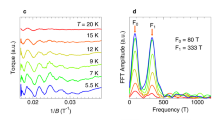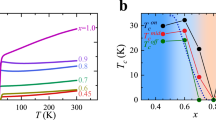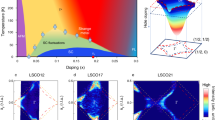Abstract
The recent discovery of superconductivity at the interface of two non-superconducting materials has received much attention1,2,3,4,5,6,7,8,9,10,11,12. In cuprate bilayers, the critical temperature (Tc) can be significantly enhanced compared with single-phase samples2,7,9. Several explanations have been proposed, invoking Sr interdiffusion2, accumulation and depletion of mobile charge carriers2,8,10, elongation of the copper-to-apical-oxygen bond length11,12, or a beneficial crosstalk between a material with a high pairing energy and another with a large phase stiffness13,14,15,16. From each of these models, one would predict Tc to depend strongly on the carrier density in the constituent materials. Here, we study combinatorial libraries of La2−xSrxCuO4–La2CuO4 bilayer samples—an unprecedentedly large set of more than 800 different compositions. The doping level x spans a wide range, 0.15 < x < 0.47, and the measured Hall coefficient varies by one order of magnitude. Nevertheless, across the entire sample set, Tc stays essentially constant at about 40 K. We infer that doping up to the optimum level does not shift the chemical potential, unlike in ordinary Fermi liquids. This result poses a new challenge to theory—cuprate superconductors have not run out of surprises.
This is a preview of subscription content, access via your institution
Access options
Subscribe to this journal
Receive 12 print issues and online access
$259.00 per year
only $21.58 per issue
Buy this article
- Purchase on Springer Link
- Instant access to full article PDF
Prices may be subject to local taxes which are calculated during checkout




Similar content being viewed by others
References
Reyren, N. et al. Superconducting interfaces between insulating oxides. Science 317, 1196–1199 (2007).
Gozar, A. et al. High-temperature interface superconductivity between metallic and insulating copper oxides. Nature 455, 782–785 (2008).
Caviglia, A. D. et al. Electric field control of the LaAlO3/SrTiO3 interface ground state. Nature 456, 624–627 (2008).
Bell, C. et al. Dominant mobility modulation by the electric field effect at the LaAlO3/SrTiO3 interface. Phys. Rev. Lett. 103, 226802 (2009).
Kozuka, Y. et al. Two-dimensional normal-state quantum oscillations in a superconducting heterostructure. Nature 462, 487–490 (2009).
Biscaras, J. et al. Two-dimensional superconductivity at a Mott insulator/band insulator interface LaTiO3/SrTiO3 . Nature Commun. 1, 89 (2010).
Logvenov, G., Gozar, A. & Bozovic, I. High-temperature superconductivity in a single copper-oxygen plane. Science 326, 699–702 (2009).
Smadici, S. et al. Superconducting transition at 38 K in insulating-overdoped La2CuO4–La1.64Sr0.36CuO4 superlattices: Evidence for interface electronic redistribution from resonant soft X-ray scattering. Phys. Rev. Lett. 102, 107004 (2009).
Koren, G. & Millo, O. Enhancement of the superconducting transition temperature of La2−xSrxCuO4 and La1.875Ba0.125CuO4 bilayers: Bilayer and reference film prepared on the same wafer. Phys. Rev. B 81, 134516 (2010).
Loktev, V. M. & Pogorelov, Yu. G. Model for modulated electronic configurations in selectively doped multilayered La2CuO4 nanostructures. Phys. Rev. B 78, 180501(R) (2008).
Butko, V. Y. et al. Madelung strain in cuprate superconductors—a route to enhancement of the critical temperature. Adv. Mater. 21, 3644–3648 (2009).
Bergman, D. L. & Pereg-Barnea, T. The origin of Tc enhancement in heterostructure cuprate superconductors. Materials 4, 1835–1845 (2011).
Kivelson, S. A. Making high Tc higher: A theoretical proposal. Physica B 318, 61–67 (2002).
Berg, E., Orgad, D. & Kivelson, S. A. Route to high-temperature superconductivity in composite systems. Phys. Rev. B 78, 094509 (2008).
Goren, L. & Altman, E. Enhancement of the superconducting transition temperature in cuprate heterostructures. Phys. Rev. B 79, 174509 (2009).
Okamoto, S. & Maier, T. A. Enhanced superconductivity in superlattices of high-Tc cuprates. Phys. Rev. Lett. 101, 156401 (2008).
Radaelli, P. G. et al. Structural and superconducting properties of La2−xSrxCuO4 as a function of Sr content. Phys. Rev. B 49, 4163–4175 (1994).
Takagi, H. et al. Systematic evolution of temperature-dependent resistivity in La2−xSrxCuO4 . Phys. Rev. Lett. 69, 2975–2978 (1992).
Ando, Y., Komiya, S., Segawa, K., Ono, S. & Kurita, Y. Electronic phase diagram of high-Tc cuprate superconductors from a mapping of the in-plane resistivity curvature. Phys. Rev. Lett. 93, 267001 (2004).
Sato, H., Tsukada, A., Naito, M. & Matsuda, A. La2−xSrxCuOy epitaxial thin films (x = 0 to 2): Structure, strain, and superconductivity. Phys. Rev. B 61, 12447–12456 (2000).
Ong, N. P. et al. Hall effect of La2−xSrxCuO4: Implications for the electronic structure in the normal state. Phys. Rev. B 35, 8807–8810 (1987).
Hwang, H. Y. et al. Scaling of the temperature dependent Hall effect in La2−xSrxCuO4 . Phys. Rev. Lett. 72, 2636–2639 (1994).
Ando, Y., Kurita, Y., Komiya, S., Ono, S. & Segawa, K. Evolution of the Hall coefficient and the peculiar electronic structure of the cuprate superconductors. Phys. Rev. Lett. 92, 197001 (2004).
Balakirev, F. F. et al. Quantum phase transition in the magnetic-field-induced normal state of optimum-doped high-Tc cuprate superconductors at low temperatures. Phys. Rev. Lett. 102, 017004 (2009).
Bozovic, I. Atomic-layer engineering of superconducting oxides: yesterday, today, tomorrow. IEEE Trans. Appl. Supercond. 11, 2686–2695 (2001).
Clayhold, J. A. et al. Combinatorial measurements of Hall effect and resistivity in oxide films. Rev. Sci. Instr. 79, 033908 (2008).
Clayhold, J. A. et al. Statistical characterization and process control for improved growth of La2−xSrxCuO4 films. J. Supercond. Nov. Magn. 22, 797–804 (2009).
Ino, A. et al. Chemical potential shift in overdoped and underdoped La2−xSrxCuO4 . Phys. Rev. Lett. 79, 2101–2104 (1997).
Hussey, N. E., Abdel-Jawad, M., Carrington, A., Mackenzie, A. P. & Balicas, L. A coherent three-dimensional Fermi surface in a high-transition-temperature superconductor. Nature 425, 814–817 (2003).
Bozovic, I. et al. No mixing of superconductivity and anti-ferromagnetism in a high-critical-temperature superconductor. Nature 422, 873–875 (2003).
Acknowledgements
The authors would like to thank A. Gozar, J. A. Clayhold and R. Sundling for valuable technical help at early stages of this work. Research supported by the US Department of Energy, Basic Energy Sciences, Materials Sciences and Engineering Division. National High Magnetic Field Laboratory is supported by the US National Science Foundation award DMR-1157490. Z.R. and M.V. also acknowledge Project No.171027 of the Serbian Ministry of Science and Education
Author information
Authors and Affiliations
Contributions
The experiment was devised by I.B. The films were synthesized and characterized by I.B., G.L. and Y-J.S., and patterned by A.T.B. The transport measurements were done by O.P. and J.W, and theoretical modeling by M.V. and Z.R. All authors contributed to the analysis and the manuscript.
Corresponding author
Ethics declarations
Competing interests
The authors declare no competing financial interests.
Supplementary information
Supplementary Information
Supplementary Information (PDF 1742 kb)
Rights and permissions
About this article
Cite this article
Wu, J., Pelleg, O., Logvenov, G. et al. Anomalous independence of interface superconductivity from carrier density. Nature Mater 12, 877–881 (2013). https://doi.org/10.1038/nmat3719
Received:
Accepted:
Published:
Issue Date:
DOI: https://doi.org/10.1038/nmat3719



